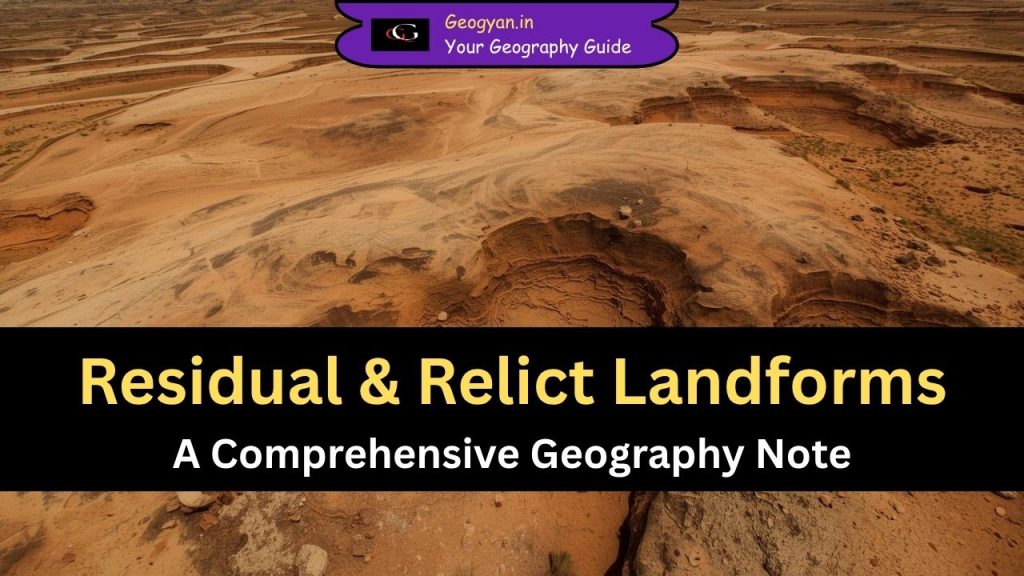Estimated reading time: 4 minutes

Table of contents
- Why Are Relict Landforms in News?
- What Is a Relict Landform?
- How Do Relict Landforms Form?
- What Are the Characteristics of Relict or Residual Landforms?
- How Are Relict Landforms Different from Active Landforms?
- What Are the Best Examples of Relict Landforms?
- How Does Climate Change Lead to the Formation of Relict Landforms?
- What Is the Significance of Relict Landforms?
- What Geological Processes Create Relict Mountains?
- How Do Relict Landforms Help Us Understand Past Environments?
- FAQs
- Also Read
Why Are Relict Landforms in News?
Recent geomorphological studies from Australia, the Amazon Basin, and Northern Europe revealed the presence of 100-million-year-old weathering profiles, ancient inselbergs, and fossil fluvial networks. These discoveries highlight how relict or inherited landforms preserve signatures of past climates no longer active today.
Relict landforms help researchers decode Earth’s climatic history, especially changes during the Cenozoic, Pleistocene Ice Ages, and Tertiary tropical periods.
What Is a Relict Landform?
A relict landform is a surviving geomorphic feature formed under past climatic or environmental conditions that are no longer active today.
Key points (Exam-Focused)
- A relict landform is created by processes that have ceased.
- It represents a climatic or geomorphic legacy of earlier environments.
- Most landscapes are palimpsests, meaning they preserve multiple generations of past processes.
Two perspectives
- Non-Glacial View: Applies to many old landforms formed under vanished climates.
- Glacial View: Refers to features preserved beneath cold-based ice with minimal deformation (e.g., ancient roches moutonnées).
How Do Relict Landforms Form?
Relict landforms form when old landforms survive despite changes in climate and active processes.
Formation Understanding
- They form under a different climate than the one that exists today.
- When climate changes, new processes do not fully erase old landforms.
- As a result, remnants of older landscapes persist for thousands to millions of years.
- These are common in polygenetic landscapes where multiple climatic regimes have shaped the terrain.
What Are the Characteristics of Relict or Residual Landforms?
Relict landforms show signals of extreme age and stability.
Major characteristics
- Longevity: Landforms (cliffs, cirques, floodplains) often outlive climatic regimes.
- Extreme Persistence: In tectonically stable regions, landforms capped by duricrusts may survive 100 million years or more.
- Low Erosion Rates: Indicates extremely low denudation (e.g., Pleistocene deposits in Nevada).
- Polygenetic Nature: Formed by multiple past processes now inactive.
How Are Relict Landforms Different from Active Landforms?
| Feature | Relict Landforms | Active Landforms |
| Process | Formed by extinct processes | Formed by ongoing processes |
| Interpretation | Must be inferred | Can be directly observed |
| Examples | Drumlins, fossil river channels | Present-day dunes, deltas |
| Age | Very old | Young |
Only a few landforms today are formed solely by active processes.
What Are the Best Examples of Relict Landforms?
Glacial & Periglacial Relicts (Ice Age survivors)
- U-shaped valleys, roches moutonnées, striations – English Lake District
- Drumlins, hummocky topography, rogens
- Ancient examples:
- Neoproterozoic roches moutonnées (Mauritania)
- Late Palaeozoic Dwyka Tillite (South Africa)
Desert Relicts
Indicators of ancient humid or arid conditions:
- Fossil river system
- High lake strandlines
- Deep weathering profiles
- Fossil dune fields
Tropical & Karst Relicts
- Fossil fluvial networks (20,000–12,500 years ago — Amazon Basin)
- Karst landscapes in Europe, Asia, North America formed under Tertiary tropical climates
- Inselbergs (e.g., Mynydd Bodafon, Kuormakka)
Ancient Erosion Surfaces
- Gondwanan & post-Gondwanan erosion surfaces in Southern Hemisphere
How Does Climate Change Lead to the Formation of Relict Landforms?
Key climatic mechanisms
1. Regime Shift Preservation
When climate shifts, new processes rarely erase the entire older landscape.
2. Past Tropical Conditions
In Cenozoic times, tropical climates extended far into higher latitudes → created deep weathering profiles.
3. Etchplanation
Julius Büdel proposed widespread etchplanation surfaces (pediments, tors, inselbergs) formed under warm, humid tropical climates.
Relict landforms become archives of vanished climates.
What Is the Significance of Relict Landforms?
Why they matter in Earth studies
- Palaeoclimate Reconstruction: Provide evidence of past warm, humid, arid, or glacial conditions.
- Actualism Principle: Helps interpret older climates using modern analogues.
- Unique Geomorphic Processes: Some features (e.g., drumlins) reflect processes with no modern analogue.
- Research Importance: Many geomorphologists build careers deciphering past climatic imprints.
What Geological Processes Create Relict Mountains?
- Etchplanation (long-term deep weathering under tropical climates)
- Saprolite Formation
- Duricrust Preservation — ferricrete, bauxite, laterite
- Tertiary tropical weathering producing fossil karst, tors, pediments
These processes create old, stable uplands that persist for millions of years.
How Do Relict Landforms Help Us Understand Past Environments?
Relict landforms act as natural archives.
They reveal:
- Past humid phases → Fossil rivers, lake strandlines, weathering profiles
- Past arid phases → Fossil dunes
- Past tropical climates → Clay-mineral signatures, saprolites
- Late Tertiary warm conditions → Karst systems, etchplain stairways
They help reconstruct Earth’s climatic evolution accurately.
Source: Fundamental of Geomorphology, Richard John Huggett
FAQs
Q1. What is the simplest definition of a relict landform?
A landform created by past climate/processes no longer active today.
Q2. Are drumlins relict landforms?
Yes. They formed under Ice Age glacial conditions not present today.
Q3. Why are relict landforms important?
They help scientists reconstruct ancient climates and understand Earth’s geomorphic history.
Q4. Can tropical weathering occur in present-day temperate regions? Not usually. But deep weathering profiles in temperate regions prove they were once tropical environments





























